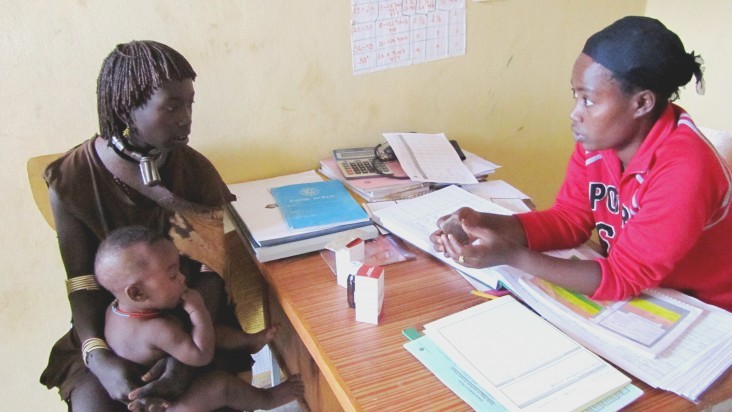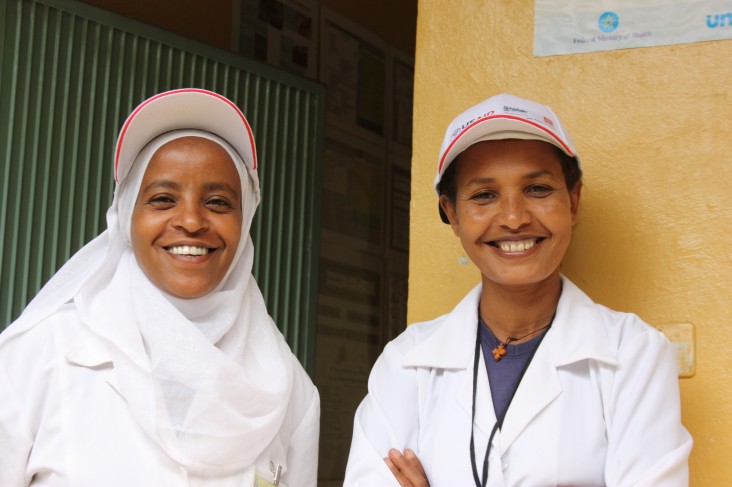Speeches Shim

Maternal and Child Health Investments, FY16: $39,000,000
Ethiopia Quick Facts: Child Health
71 percent reduction in child mortality rates, 1990-20151
20,000 health workers trained in child health and nutrition by USAID in 20152
More than 1 million children under 5 reached with health services by USAID in 20153
When 8-month-old Bora Shewki of Ethiopia’s Hamer woreda (district) began suffering from a poor appetite, cough and fever, Kari Turle, his mother, recognized the symptoms right away: Bora had contracted pneumonia. Kari, a pastoralist in the South Omo Valley, had seen the illness before, and said she used to take her sick children “to the health center, which is very far from where I live.” This time, though, she was able to find treatment for Bora at the nearby Aera Keysa health post, where health extension workers had recently been trained in treating childhood illnesses such as pneumonia, diarrhea, malaria and malnutrition through a strategy to expand community-level access to lifesaving treatments.4
The health extension worker who likely saved Bora’s life, Tarikua Lulayehu, was trained to identify and treat common childhood illnesses through the Health Extension Program, begun by the Government of Ethiopia in 2004. The program trains young women to provide basic health services and deploys them in pairs to rural villages around the country, where they provide essential services and empower communities to take charge of their own health.
Health extension workers such as Tarikua form the backbone of Ethiopia’s health care system. They receive training in a number of health-related skills, including Integrated Community Case Management (iCCM), a strategy to expand access within communities to lifesaving treatment for children suffering from pneumonia, diarrhea and malaria.
Today, Tarikua takes pride in the iCCM training that she received and in her exemplary health post, a model facility that has applied all 16 elements of the Health Extension Program. “Before I attended the iCCM training, I did not have the skills to treat sick children, especially those who suffered from pneumonia,” Tarikua says. “All I did was send them to the health center with a referral slip. Now that I have the skills, I assess, classify and treat sick children and provide medication accordingly. I write referrals only for severe cases.”
A MODEL FOR CHILD SURVIVAL
In 1990, Ethiopia’s child mortality rate was among the highest in the world at 205 under-5 child deaths per 1,000 live births; as of 2015, this figure had fallen to 59 per 1,000 -- a 71 percent reduction.5 Using innovative strategies like the Health Extension Program, Ethiopia managed to overcome significant hurdles such as a severe shortage of doctors and a rural landscape.
USAID efforts in Ethiopia have contributed to this success. USAID supports the Ethiopian government’s Health Extension Program and works with local districts to provide training for health extension workers, who are then able to reach rural communities with basic health services. In 2016, USAID supported the training of more than 38,000 health workers in child health and nutrition, who help provide care throughout the country.6

Our work in Ethiopia is part of USAID’s approach to helping children around the world survive and thrive. In the 2014 Acting on the Call report, USAID formulated a roadmap for using data-driven investments and high-impact interventions to save the lives of 15 million children and 600,000 mothers by 2020. The 2015 report provided country-by-country progress updates and included data on the number of lives that could be saved through an expansion of recommended interventions -- including 815,000 children in Ethiopia.
USAID’s maternal and child survival efforts contribute to American and global security and energize economies worldwide. Through continued support in Ethiopia and other USAID priority countries, our goal to end preventable child and maternal deaths within a generation helps ensure a safer and more prosperous future
Meet more of the women and children that benefit from USAID's efforts.
« Back to the Acting on the Call home page
1 Levels and Trends in Child Mortality: Report 2015. UNICEF, September 2015.
2 Ibid.
3 Ibid.
4 Ethiopia Models Child Survival Success. USAID Frontlines, May/June 2014.
5 Levels and Trends in Child Mortality: Report 2015. UNICEF, September 2015.
6 Acting on the Call: Ending Preventable Child and Maternal Deaths. USAID, May 2017.

Comment
Make a general inquiry or suggest an improvement.